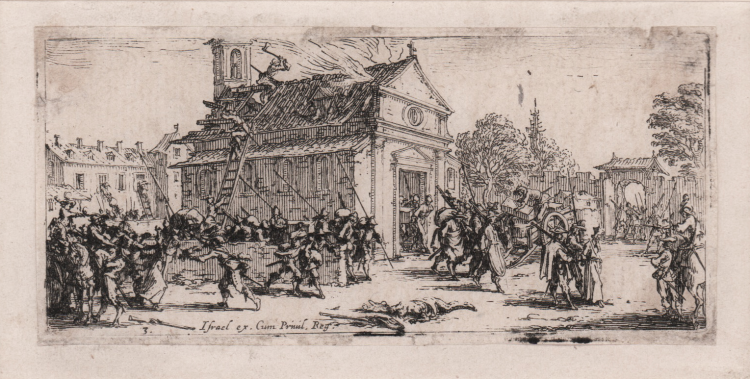



| Reference: | S29186 |
| Author | Jacques CALLOT |
| Year: | 1632 ca. |
| Measures: | 116 x 55 mm |


| Reference: | S29186 |
| Author | Jacques CALLOT |
| Year: | 1632 ca. |
| Measures: | 116 x 55 mm |
Etchiing, 1632/5 circa, from the "Les petites misères de la guerre".
Example in the second state of two, with the address of publisher Israel Henriet, dated 1636 in the title.
The series consists of six incisions on the title page, engraved by Abraham Bosse. The works chronologically precede the series masterful "Great miseries of war", composed of 18 plates.
Etching, magnificent proof, printed on contemporary laid paper, with thin margins or trimmed with copper, laid down on antique mounting, in good condition.
|
Lieure 1333-1338 II/II; H. Diane Russell., Jacques Callot prints & Related Drawings pp. 60-62.
|
Jacques CALLOT (Nancy 1592 - 1635)
|
He was a baroque graphics artist, draftsman and printmaker from the Duchy of Lorraine (an independant state on the North-Eastern border with France). He made etchings that chronicled the people and the life of his period (soldiers, clowns, drunkards, wanderers, beggars, and various outcasts). These images of people are often contrasted by spectacular landscapes (see, for instance, "The Temptation of St. Anthony"). His skill in shading and his use of different tones were remarkable for the period and he is often compared to Albrecht Dürer.
|
|
Lieure 1333-1338 II/II; H. Diane Russell., Jacques Callot prints & Related Drawings pp. 60-62.
|
Jacques CALLOT (Nancy 1592 - 1635)
|
He was a baroque graphics artist, draftsman and printmaker from the Duchy of Lorraine (an independant state on the North-Eastern border with France). He made etchings that chronicled the people and the life of his period (soldiers, clowns, drunkards, wanderers, beggars, and various outcasts). These images of people are often contrasted by spectacular landscapes (see, for instance, "The Temptation of St. Anthony"). His skill in shading and his use of different tones were remarkable for the period and he is often compared to Albrecht Dürer.
|